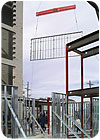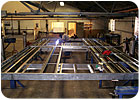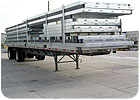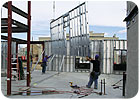
Many factors affect the construction market today, from prices on raw commodities such as wood and steel, to the sometimes fluctuating job-site labor rates. Controlling these costs, and decreasing installation time is vital to the success of any project. Such factors create a demand for high-quality systems that are easy to install, yet economical. Pre-panelized wall systems using cold-formed steel (CFS) have emerged as one such solution.
Pre-fabricated CFS wall panels have been establishing themselves in the building market ever since the invention of the self-drilling screw in the 1960s, and they continue to gain momentum today.
$2 BILLION STEEL STUD MARKET
What started out as a simple C-stud and track member used for interior non-load bearing partition walls has grown into over a $2 billion steel stud market. While the non-load bearing system has remained relatively stable over the past decade, the structural market for CFS continues to evolve. Manufacturers have expanded their inventories to include thicker, stronger sections that are easier to install. Specialized CFS sections that simplify installation or reduce material costs are constantly being introduced.For example, single-leg and double-leg headers are now commonly used to support openings on load-bearing walls. These one-piece products have replaced the labor-intensive boxed headers that required the combination of multiple studs and track in the shape of a box.
Heavy-duty studs have recently come to market. These products have a larger profile with several additional bends that contribute to its increased capacity. Just one of these products is often equivalent to several standard studs that would need to be connected together.
While infusion of new and creative products allowed CFS to penetrate a market that was dominated by wood products, it is the development of computer software programs, created specifically for the layout of CFS wall systems, that has allowed the walls to be built in a high-volume panel fabrication shop. The software essentially allows a designer to lay out and design the building in 3-D space. From this model, the project can be bid and panels can be fabricated, as well as stacked for shipment to the jobsite. The pre-fabrication of these panels within a factory-controlled shop ensures the panels are built exactly to specifications.
PANELIZATION FROM START TO FINISH
Ideally, the panelization process should start in the early stages of design development. Locking the job in as a panelized project from the start allows the contract documents to reflect proper engineering, detailing, as well as clear and concise bidding. This idealistic approach is often not the case. The trend in the industry has been to shift the engineering and detailing responsibility to the panel fabricator as part of the design/build process. While this can place an added burden on the fabricator, it also allows for flexibility to design the most efficient panelized system.Since most wall panelizers do not employ a professional engineer on staff, it is a good idea to develop a strong working relationship with an outside engineer that has a solid understanding of CFS design and panelization. Another option is to contact one of the full-service CFS manufacturers that have engineering departments dedicated to designing CFS projects. If the engineering responsibility is placed on the fabricator, it is important that the fabricator include this fee in the bid of the project along with material, labor, and transportation costs.
Other items to be defined in the bid are limits of liability, schedule, and inclusion or exclusion of sheathing and miscellaneous connections such as embeds and/or other connectors for attachment of the panels.

Fabrication
Once a bid proposal is accepted, the next step is fabrication. An efficiently set-up fabrication shop, along with a quality framing jig, are two of the most important elements needed for successful panelization. Material must efficiently flow into the shop, and panels must efficiently flow out of the shop. In order for this to happen, it is a good idea to have dedicated staging areas in the shop.1. A specialized area should be established to cut down material to required lengths.
2. Material can flow from cutting to a subassembly area, where special jigs are used to build components such as windows, doors, and posts.
3. All materials come together at the main framing jig. Components are combined with typical wall studs and track to create the final panel. Sheathing and finish material may also be applied at this point.
When assembling load-bearing panels, the jig must be a compression jig that effectively seats the top and bottom tracks into the studs. A gap of 1/8-inch is all that is allowed between the end of the stud and the web of the track.
CFS panel materials are typically connected together with self-drilling screws or welding. Because efficiency is the key, quite often a combination of both types of connections is used. When it is more efficient to weld, the members should be welded.
Welding operations generally need to be isolated from the finish areas of the shop due to ventilation requirements, weld flash protection and cleanliness. Also, welds must be touched up with a zinc-rich paint.

Transportation
Most panels are transported to the jobsite by semi-trailer. Panels can be loaded on the trailer in bundles or one-by-one; they can be stood up vertically or laid flat. Either way, care must be taken to protect the panel material, sheathing, and/or finish surface when loading and securing the panels to the trailer. Panels should be sized with transportation requirements in mind. Wide or excessively tall loads will require the purchase of special permits for each state entered, and travel times may be restricted.
Erection
The final phase of the panel process is erecting the panels. The panel fabricator may take on this responsibility, or the contractor can do this himself. Either way, the process tends to go quickly, since the panels simply need to be set in place and fastened at the top and bottom track per the engineered design. To aid in the location of each panel on the project, a detailed plan is provided. On multi-story projects, panels can be stockpiled, so that as soon as one level is completed the next level can be started. This process can reduce project schedules immensely, especially on a project where the winter months are approaching and the building needs to be enclosed. Crane service can also have a significant impact on erection costs and productivity.Software
Manufacturing CFS panels is a specialty business with its own set of challenges. Software created to aid in the process of laying out wall panels, bidding the job, fabricating the panels, and in some cases, engineering CFS panels, streamlines the process.These programs allow a panel designer to efficiently layout all members of the CFS walls including windows, doors, posts, shear walls and any other components needed. Details specific to CFS members, such as the direction the stud is facing and how a stud frames into a track, are taken into account to provide detailed member reports and panel drawings. Numerous automated features and options provide flexibility for creating even the most complicated panels. Additional features include reports that provide linear feet of material, material cost, cut list, fabrication drawings, stacking reports and many others that simplify the production of panels. Some advanced programs offer analysis for gravity and lateral loads on the panels.
The power is in the software. Bidding and fabricating a panel job is very complicated. The use of panel software takes a lot of the guesswork out of the process as it assists with every stage of the process from bidding to erection. If a panel fabricator chooses not to utilize one of these software packages, they will most likely be at a disadvantage in the marketplace.
Conclusion
The key to any panelized project is extensive pre-planning. Poor planning and information can lead to panels that do not fit correctly, and modifying prefabricated panels is not easy. Having the proper personnel and technology in place will allow for a smooth flowing construction process. Accurate computer software can be instrumental in all phases of the project. Additionally, hiring an experienced panel fabricator that understands the process and will seek answers to potential problems before panels are built can save considerable time and money.CFS prefabricated panels have proven to be a viable solution that counters many of the issues that exist in the construction market today. Specifying CFS pre-fabricated wall panels can assist in controlling labor costs and reduced scheduling, without sacrificing quality.
SIDEBAR:
Benefits of Cold-Formed Steel
· Consistency: CFS has consistent material quality that is roll formed into precise uniform shapes. The members are straight; they will not warp, twist, bow, split, or shrink.· Durability: Does not rot, promote mold or mildew; and is impermeable to termites, vermin and insects.
· Versatility: Available in a wide variety of sizes, thicknesses and configurations; each with unique properties that can be matched to the requirements of the project.
· Strength/Weight: High strength-to-weight ratio. Steel framing can weigh substantially less than other materials. This helps reduce the overall structure weight, which in turn often reduces material requirements on lower floors and foundations.
· Fire Resistant: Non-combustible and improves fire safety in compliance with local codes and regulations.
· Environmentally Friendly: Steel is considered a green building material. It has a high recycled content, and can be a significant contributor to the LEED certification process.
Benefits of Pre-fabricated Wall Panels:
· Weather: Panels are fabricated in an off-site facility with a controlled environment that is not affected by inclement weather. This is especially important in cold and rainy climates.
· Productivity: A good manufacturing facility will have a smooth flow of material through the building and may use state-of-the-art computer technology to create elaborate framing jigs that simplify panel layout, laser projection units and specialized software to provide accurate material counts, material cutting reports, and fabrication drawings. These efficiencies can result in swift production of even complicated panels.
· Efficiency: Panel fabrication can take place before the foundation of structural systems are constructed on-site. Along with the ease of on-site erection, pre-fab panels can reduce the time required to enclose the building envelope, thus reducing the schedule on the project.
· Quality: All of the factors listed above contribute to the very important benefit of quality. An organized manufacturing facility coupled with technology and efficient supervision will provide high levels of quality in the finished product.
· Labor Rates: Off-site fabrication can often be performed at reduced labor rates, especially in high labor-rate areas.



